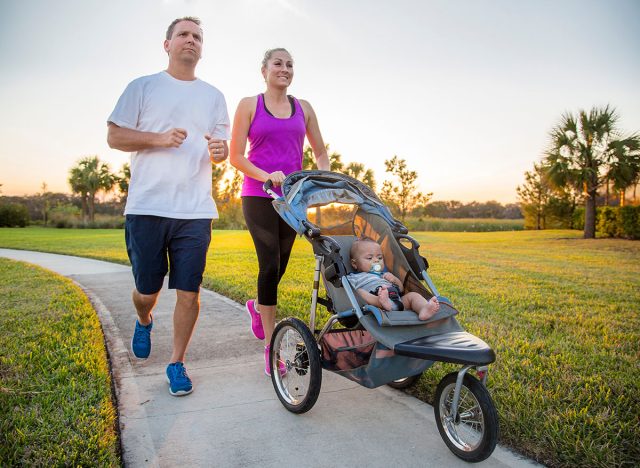Here's How Long Your Evening Walking Workout Should Be To Shrink Belly Fat

Evening walks do more than help you unwind after a long day—they can be a powerful tool for fat loss, especially around the midsection. When timed right and done at the right intensity, an evening walk helps regulate blood sugar levels, improve digestion, and optimize fat metabolism. It's an easy, low-impact habit that fits seamlessly into your routine while supporting weight loss goals. Plus, walking at night reduces stress and curbs late-night cravings, both of which play a crucial role in belly fat accumulation.
But how long should you walk to see real results? The answer isn't just about time, it's about walking at the right intensity, maintaining consistency, and using smart fat-burning strategies. Whether you're looking to boost metabolism, improve hormone balance, or simply burn extra calories, your evening walking workout can make a significant difference. Let's break down the ideal duration and intensity to help you maximize your belly fat-burning potential.
The Science Behind Evening Walks & Belly Fat Loss

Walking at night is a wonderful addition to any weight loss workout plan. After dinner, blood sugar levels rise, and movement may help shuttle glucose into muscles instead of storing it as fat. A post-meal walk also improves digestion, reducing bloating and sluggishness.
Cortisol, the body's stress hormone, plays a significant role in belly fat accumulation. High cortisol levels signal your body to store fat around the midsection, especially when dealing with chronic stress. Walking lowers cortisol and triggers the release of endorphins, improving mood while making fat loss more efficient. Unlike high-intensity workouts, which can spike appetite, evening walks help control cravings and prevent late-night snacking.
Sleep quality also impacts weight loss, and walking in the evening promotes better rest by regulating circadian rhythms. Poor sleep leads to increased ghrelin (the hunger hormone) and decreased leptin (the hormone that signals fullness), making it harder to manage weight. By incorporating an evening walk, you're not just burning calories but also setting up your body for better hormonal balance.
Key takeaway: Walking after dinner optimizes fat metabolism, improves digestion, lowers stress hormones, and reduces late-night cravings—all of which help shrink belly fat.
The Ideal Duration & Intensity for Maximum Fat Burn

If you want to burn belly fat efficiently, your evening walk's duration and intensity matter. The best results come from a brisk walk lasting 30 to 60 minutes. The exact time depends on your fitness level. Beginners may start with 30 minutes, while those aiming for faster fat loss can extend it to 45–60 minutes for a more significant calorie deficit.
Intensity is just as important as duration. A slow, leisurely stroll won't deliver significant fat-burning benefits. Instead, aim for a pace of 3.5 to 4 mph, where you can still hold a conversation but feel slightly out of breath. If you're tracking effort, aim for about 60–70% of your max heart rate (Zone 2 cardio), which is ideal for fat oxidation.
For even greater results, consider interval walking:
- Walk at a normal pace for two minutes
- Speed up to a fast walk for one minute
- Repeat the cycle throughout your workout
This method boosts post-exercise calorie burn and increases overall fat loss. If you track your steps, hitting 7,000 to 10,000 steps daily ensures you're moving enough to create a sustainable calorie deficit.
Key takeaway: Walk briskly for 30 to 60 minutes or use intervals to elevate heart rate and maximize fat burn. Step-count goals of 7,000–10,000 steps daily will keep you on track.
Evening Walking Strategies To Speed Up Fat Loss

If you're already walking in the evening but want to see results faster, these strategies can turn a typical walk into an optimal fat-burning opportunity:
- Walk on an Incline or Stairs: Walking uphill or incorporating stairs recruits more muscle fibers, especially in the glutes, hamstrings, and calves. Compared to walking on a flat surface, this increases calorie burn and accelerates fat loss. If you're on a treadmill, set the incline to 5–8% to simulate outdoor hills.
- Wear a Weighted Vest or Carry Light Dumbbells: A weighted vest (5–10% of your body weight) adds resistance without increasing joint impact, increasing heart rate and boosting calorie expenditure. Avoid ankle or wrist weights, as they can cause unnatural movement patterns.
- Try Interval-Based Walking: To maximize fat loss, incorporate speed intervals:
- Walk at a moderate pace for 3 minutes, then
- Walk at a fast pace (almost a jog) for 1 minute
- Repeat for the duration of your workout
This method mimics HIIT (high-intensity interval training) principles, keeping your metabolism elevated even after you stop walking.
- Add Bodyweight Exercises: Break up your walk with short strength exercises:
- Every 5–10 minutes, stop for 10 squats, 10 lunges, or 10 push-ups
- This engages more muscles, keeps your heart rate high, and increases total energy burn
- Focus on Hydration and Meal Timing: Dehydration slows metabolism, so drink water before and after walking. Avoid heavy meals right before heading out, as they can cause sluggishness. Eat a light, protein-rich snack before your walk to sustain energy levels.
The Bottom Line
Evening walks do more than burn calories—they reduce stress, improve sleep, regulate hormones, and promote long-term fat loss. Aim for a brisk 30–60-minute walk at 3.5–4 mph to maximize belly fat reduction, or use intervals to elevate intensity. Want faster results? Add inclines, resistance, or bodyweight exercises to your routine.
Most importantly, stay consistent. An evening walk isn't a quick fix, and it's a sustainable habit that keeps your body burning fat night after night. So lace up those sneakers, step outside, and start walking toward a leaner, healthier you! And if you enjoyed this article, don't miss How Long Your Walking Workout Should Be To Shrink Belly Fat.
References
- Abraham, S B et al. "Cortisol, obesity, and the metabolic syndrome: a cross-sectional study of obese subjects and review of the literature." Obesity (Silver Spring, Md.) vol. 21,1 (2013): E105-17. doi:10.1002/oby.20083
- De Nys, Len et al. "The effects of physical activity on cortisol and sleep: A systematic review and meta-analysis." Psychoneuroendocrinology vol. 143 (2022): 105843. doi:10.1016/j.psyneuen.2022.105843
- Papatriantafyllou, Evangelia et al. "Sleep Deprivation: Effects on Weight Loss and Weight Loss Maintenance." Nutrients vol. 14,8 1549. 8 Apr. 2022, doi:10.3390/nu14081549









